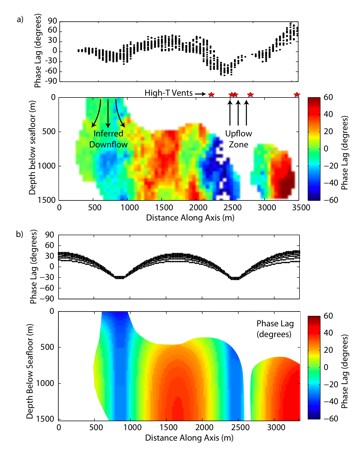Crone
Using Two-Dimensional Models of Poroelastic Fluid Flow to Constrain the Permeability Structure of Young Oceanic Crust
T.J. Crone¹*, M. Tolstoy¹, & D.F. Stroup Sumy¹
Corresponding author: crone@ldeo.columbia.edu
¹Lamont–Doherty Earth Observatory, Columbia University, Palisades, New York 10964
Abstract:
EPR microseismicity data from 2003 – 2004 contain along-axis tidal triggering patterns indicating that earthquakes along some sections of the ridge tend to occur before times of maximal predicted extensional stress, and earthquakes along other sections tend to occur after times of maximal extensional stress. Average earthquake initiation times trace out a wave-like pattern along the ridge axis (Figure 1a). One potential explanation for this pattern is that pore pressure perturbations generated by tidal forces and modulated by crustal permeability structure propagate along axis to increase the likelihood of rupture by lowering normal stresses on fault surfaces.
We are currently developing two-dimensional numerical models of poroelastic fluid flow in order to explore this possibility and understand the implications for the permeability structure of the crust at the EPR. Preliminary results show that the phases of volumetric stresses inferred from the earthquake data can be closely matched using realistic permeability values and simple permeability distributions (Figure 1b). These models predict that the average permeability in the upper 1.5 km of crust in the along-axis direction is about 10-12 m2, which is consistent with estimates based on heat flow models. Because these results are dependent upon the relative magnitudes of ocean tidal loading stresses and Earth tide stresses, which are poorly constrained in these environments by global tide models, field studies using geodetic measurements may help further constrain these results.
Keywords:
Numerical modeling, tidally triggered earthquakes, poroelastic fluid flow, crustal permeability
Contributions to Integration and Synthesis:
Results from our modeling efforts can be used to bring new insights into the permeability structure of young oceanic crust, and can potentially be used to inform and constrain other numerical models of porous convection, heat flux, and geochemical processes. A better understanding of the permeability structure in these systems will allow the development of more realistic models of hydrothermal flow, which will aid our understanding of processes ranging from geochemical alteration to biological productivity.
These models can also be used to generate hypotheses regarding crustal deformation that can be tested using seafloor geodetic surveys, and the numerical modeling techniques that we are developing can be applied to passive seismic survey data collected at other R2K study sites, including the TAG hydrothermal mound and the Endeavour segment of the Juan de Fuca Ridge. We will be carrying out many of these comparison and integration studies in the coming year.
Figures:
Figure 1a) Stacked and spatially averaged earthquake initiation times relative to the phase of the predicted combined Earth and ocean tidal loading stresses (Stroup et al., In Review), and 2b) modeled relative effective stresses in the poroelastic model. Upper panels show the data projected onto a single along-axis dimension. Lower panels show the same data in two-dimensions. The model suggests that along-axis permeability variations can generate tidal stress lags that are similar to the stresses inferred from microearthquake data. Crone_fig1.jpg

